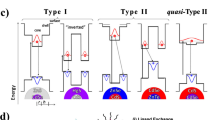Abstract
We propose a novel concept of optical detection of thermal neutrons in a passive device that exploits transmutation of Dy-164, a dominant, naturally occurring isotope of dysprosium, into a stable isotope of either holmium Ho-165 or erbium Er-166. Combination of the high thermal neutron capture cross section of ~2,650 barns and transmutation into two other lanthanides makes Dy-164 a very attractive alternative to traditional methods of neutron detection that will be completely insensitive to gamma irradiation, thus reducing greatly the likelihood of false alarms. The optically enabled neutron detection relies on significant differences in optical properties of Dy, Ho, and Er that are not sensitive to a particular isotope, but change considerably from one element to another. While the concept applies equally well to bulk materials and to nanocrystals, nanocrystalline approach is much more attractive due to its significantly lower cost, relative ease of colloidal synthesis of high quality nanocrystals (NCs), and superior optical and mechanical properties of NCs compared to their bulk counterparts. We report on colloidal synthesis of DyF3 NCs, both doped and undoped with Ho and co-doped with Ce and Eu to enhance their optical properties. We also report on DyF3:10%Ce and DyF3:10%Eu NCs irradiated with thermal neutrons from a Cf-252 source and their optical characterization.
Similar content being viewed by others
References
G. F. Knoll, Radiation Detection and Measurement, 3rd Ed., John Wiley & Sons, pp. 507–520 (2000).
D. Kramer, Physics Today, pp. 20–22, May 2011.
R. B. Firestone, Berkeley Laboratory Isotopes Project, E. O. Lawrence Berkeley National Lab., http://ie.lbl.gov/education/isotopes.htm
A. B. McLaren, E. L. R. Hetherington, D. J. Maddalena, and G. M.Snowdon, Australian Nuclear Science and Technology Organization, Lucas Heights Research Laboratories, Report ANSTO/E673, (1988).
C. Furetta, J. W. N. Tuyn, F. Lewis, J. Azorin, and C. M. H. Driscoll, Radiation Protection Dosimetry 17, pp. 161–164 (1986).
N. J. Withers, J. B. Plumley, B. A. Akins, A. C. Rivera, G. Medina, G. A. Smolyakov, G. S. Timmins, and M. Osiński, Colloidal Quantum Dots for Biomedical Applications V (M. Osiński, W. J. Parak, T. M. Jovin, and K. Yamamoto, Eds.), San Francisco, CA, 23–25 Jan. 2010, Proc. SPIE 7575, Paper 75750Z (10 pp.).
M. M. Hoffmann, J. S. Young, and J. L. Fulton, J. Nuclear Science, 35 (16) 4177–4183 (2000).
Author information
Authors and Affiliations
Corresponding author
Rights and permissions
About this article
Cite this article
Rivera, A.C., Glazener, N.N., Cook, N.C. et al. Dysprosium-Containing Nanocrystals for Thermal Neutron Detection. MRS Online Proceedings Library 1341, 902 (2011). https://doi.org/10.1557/opl.2011.1484
Published:
DOI: https://doi.org/10.1557/opl.2011.1484




